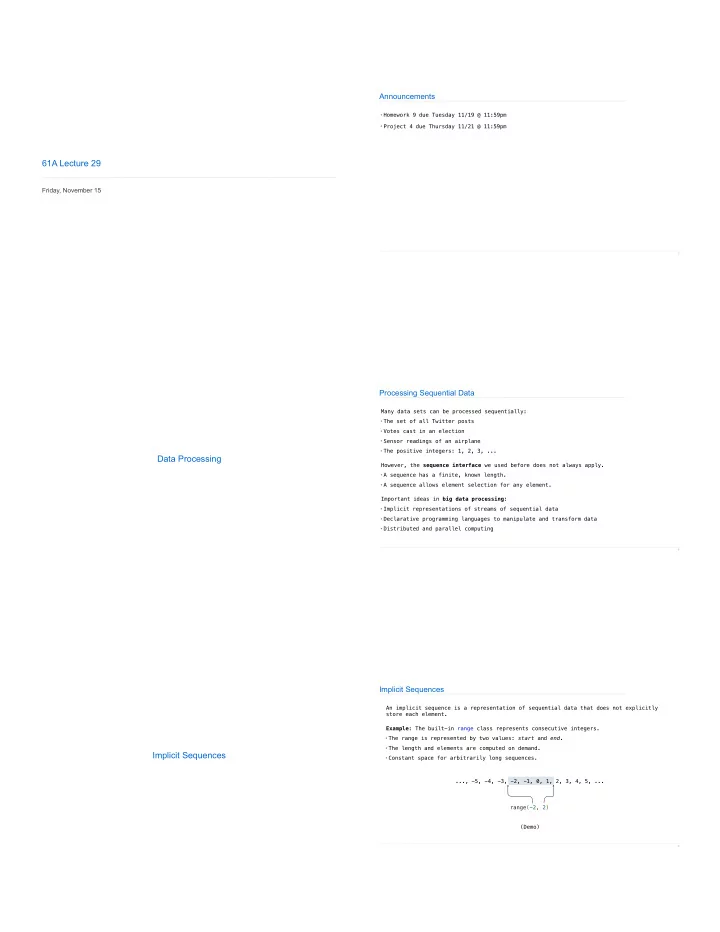

Announcements • Homework 9 due Tuesday 11/19 @ 11:59pm • Project 4 due Thursday 11/21 @ 11:59pm 61A Lecture 29 Friday, November 15 2 Processing Sequential Data Many data sets can be processed sequentially: • The set of all Twitter posts • Votes cast in an election • Sensor readings of an airplane • The positive integers: 1, 2, 3, ... Data Processing However, the sequence interface we used before does not always apply. • A sequence has a finite, known length. • A sequence allows element selection for any element. Important ideas in big data processing : • Implicit representations of streams of sequential data • Declarative programming languages to manipulate and transform data • Distributed and parallel computing 4 Implicit Sequences An implicit sequence is a representation of sequential data that does not explicitly store each element. Example : The built-in range class represents consecutive integers. • The range is represented by two values: start and end . • The length and elements are computed on demand. Implicit Sequences • Constant space for arbitrarily long sequences. ..., -5, -4, -3, -2, -1, 0, 1, 2, 3, 4, 5, ... range(-2, 2) (Demo) 6
The Iterator Interface An iterator is an object that can provide the next element of a sequence. The __next__ method of an iterator returns the next element. The built-in next function invokes the __next__ method on its argument. If there is no next element, then the __next__ method of an iterator should raise a Iterators StopIteration exception. ..., -5, -4, -3, -2, -1, 0, 1, 2, 3, 4, 5, ... iter( range(-2, 2) next( <range_iterator object> ) returns ) Invokes __iter__ on its argument (Demo) 8 Iterables and Iterators Iterator: Mutable object that tracks a position in a sequence, advancing on __next__. Iterable: Represents a sequence and returns a new iterator on __iter__. LetterIter is an iterator : LetterIter('a', 'e') Iterable Objects LetterIter('a', 'e') Letters is iterable : Letters('a', 'e') 'a' 'b' 'c' 'd' (Demo) 10 The For Statement for <name> in <expression>: <suite> 1.Evaluate the header <expression>, which yields an iterable object. 2.For each element in that sequence, in order: A.Bind <name> to that element in the first frame of the current environment. B.Execute the <suite>. For Statements When executing a for statement, __iter__ returns an iterator and __next__ provides each item: >>> counts = [1, 2, 3] >>> counts = [1, 2, 3] >>> for item in counts: >>> items = counts.__iter__() print(item) >>> try : 1 while True : 2 item = items.__next__() 3 print(item) except StopIteration: pass 1 2 3 12
Generators and Generator Functions A generator is an iterator backed by a generator function. A generator function is a function that yields values. When a generator function is called, it returns a generator. Generator Functions >>> def letters_generator(next_letter, end): ... while next_letter < end: ... yield next_letter ... next_letter = chr(ord(next_letter)+1) >>> for letter in letters_generator('a', 'e'): ... print (letter) a b c d (Demo) 14 Generator Examples fib_generator(): "Yield Fibonacci numbers." all_pairs(s): "Yield pairs of elements from iterable s." Letters.__iter__(): "Yield sequential letters." powerset(t): "Yield all subsets of iterator t." 15
Recommend
More recommend